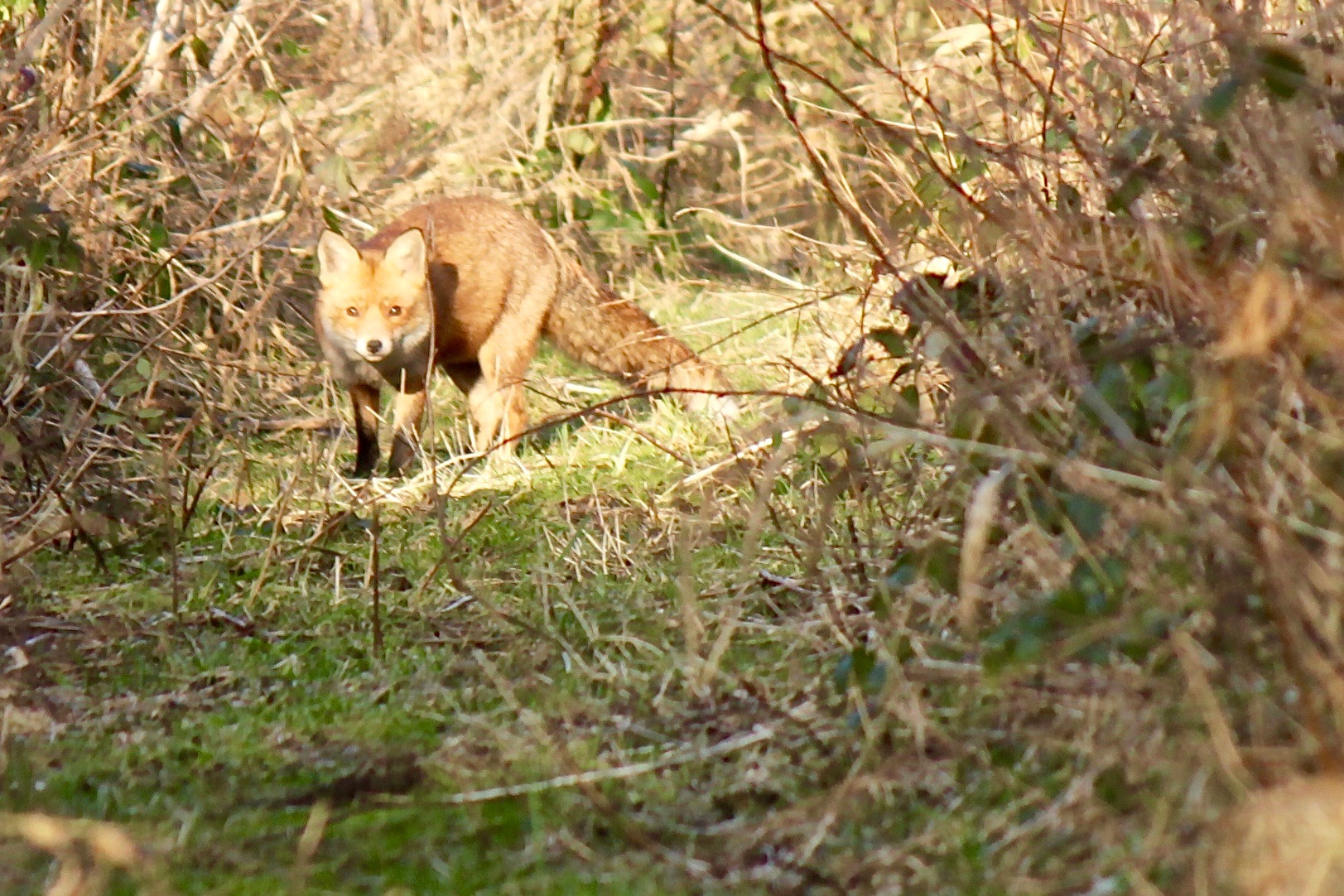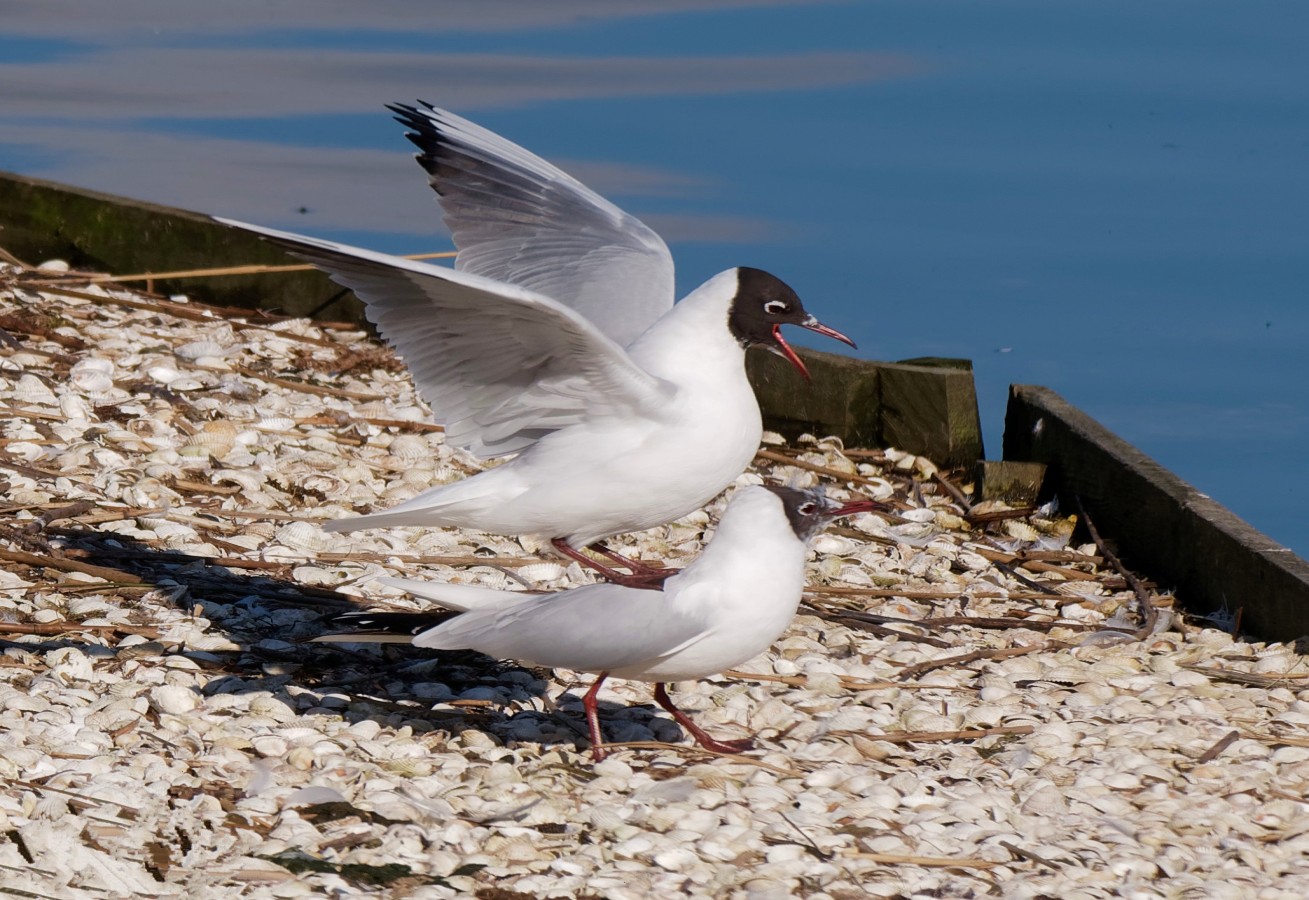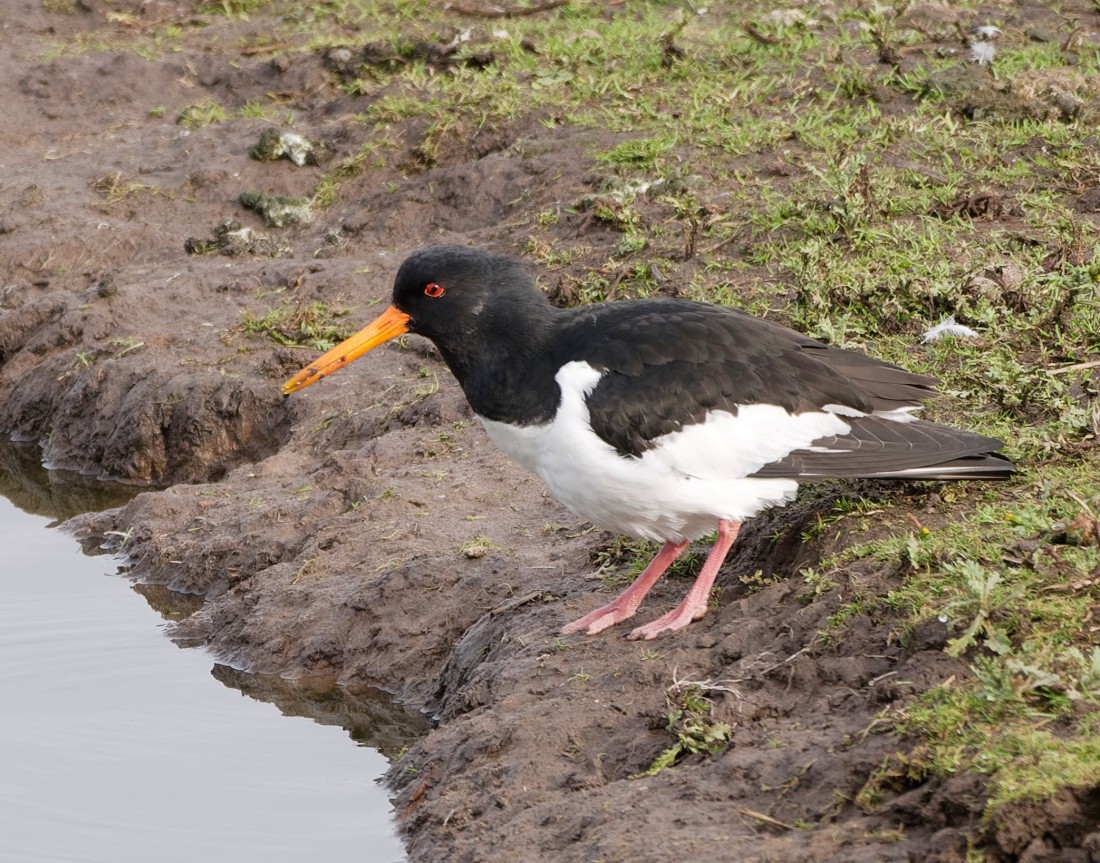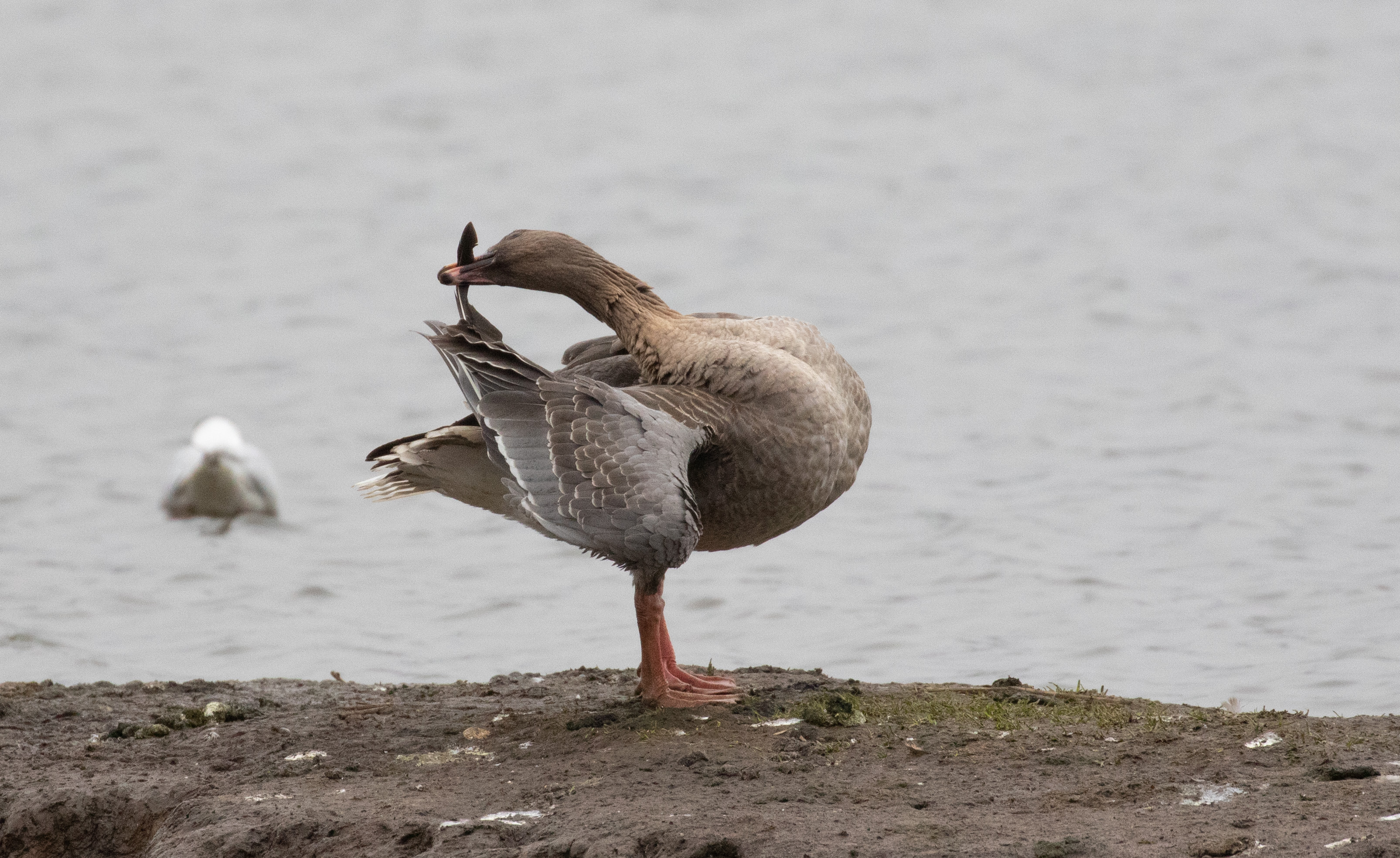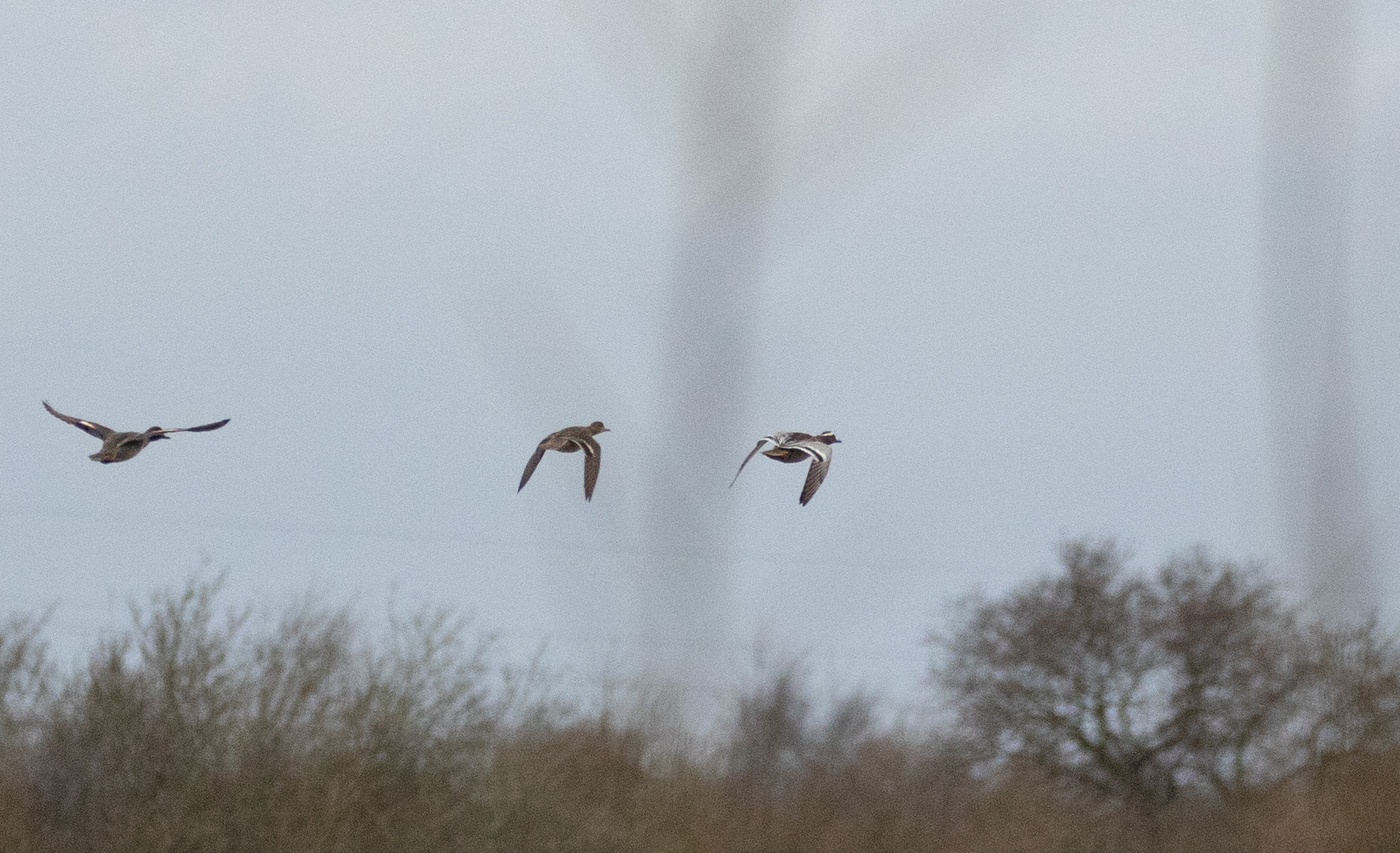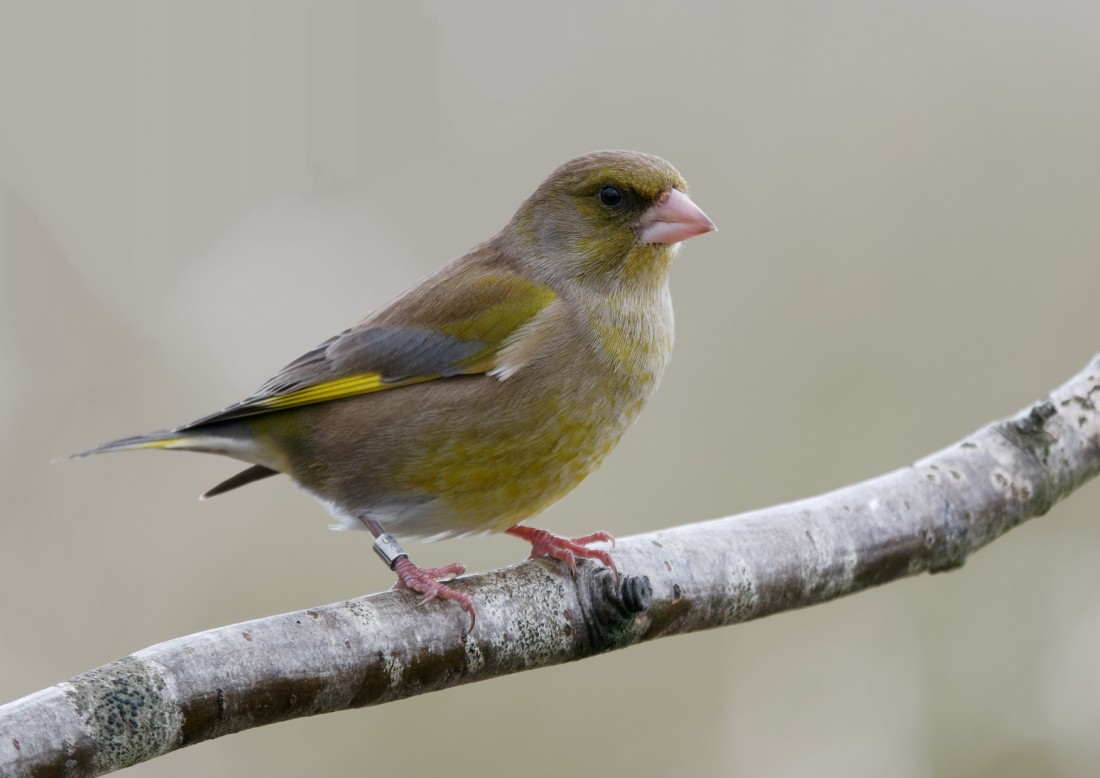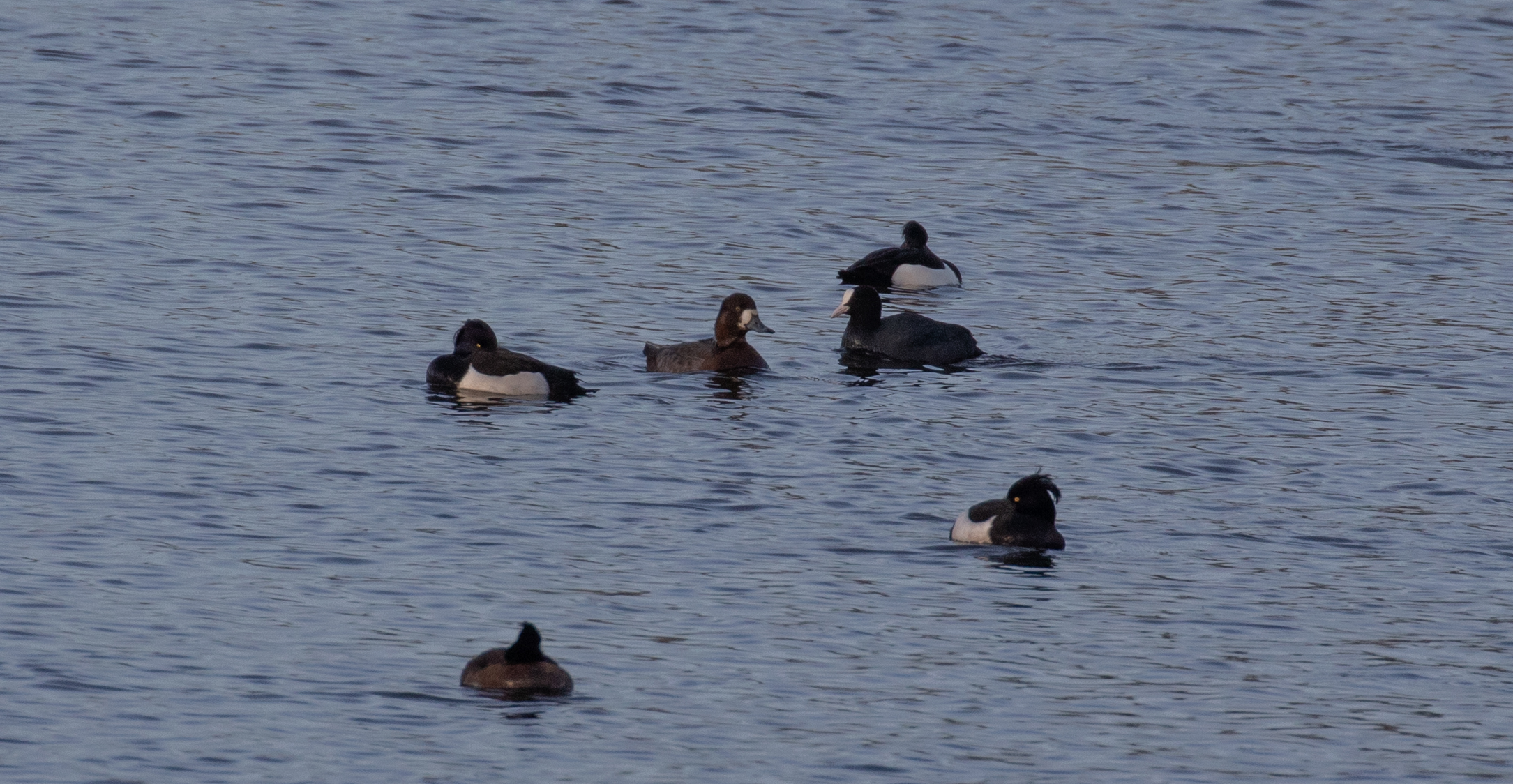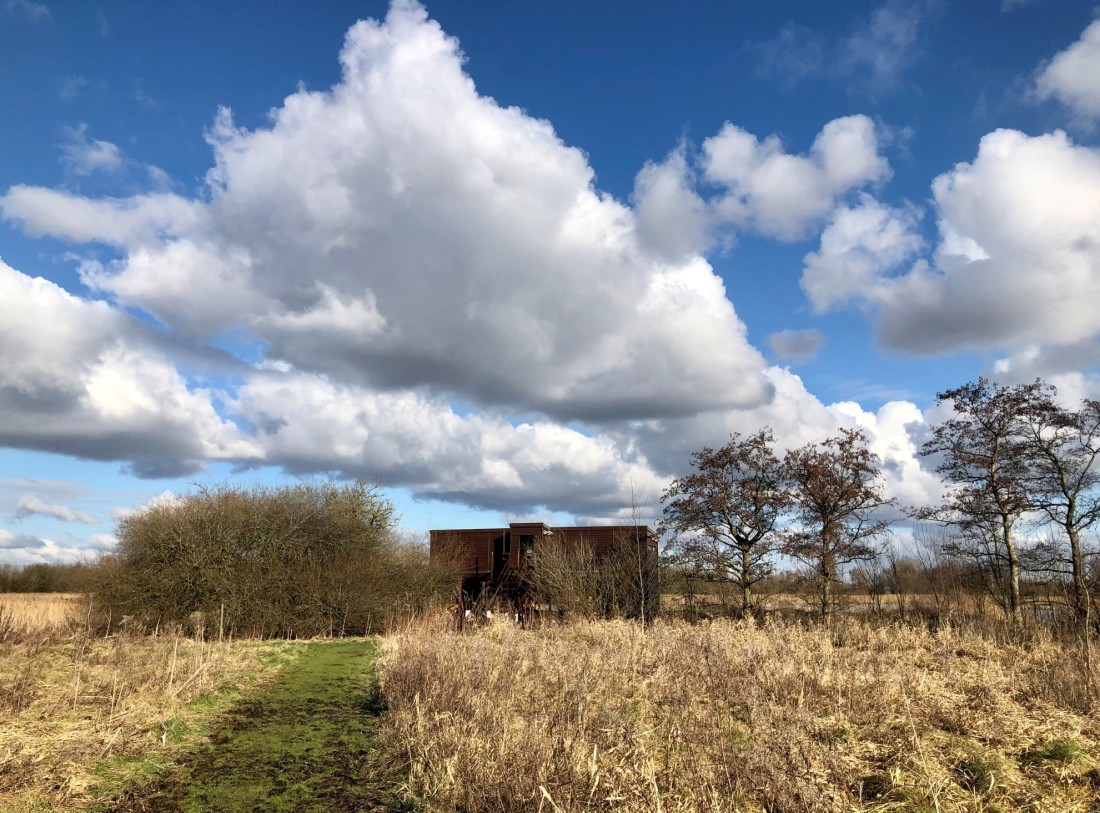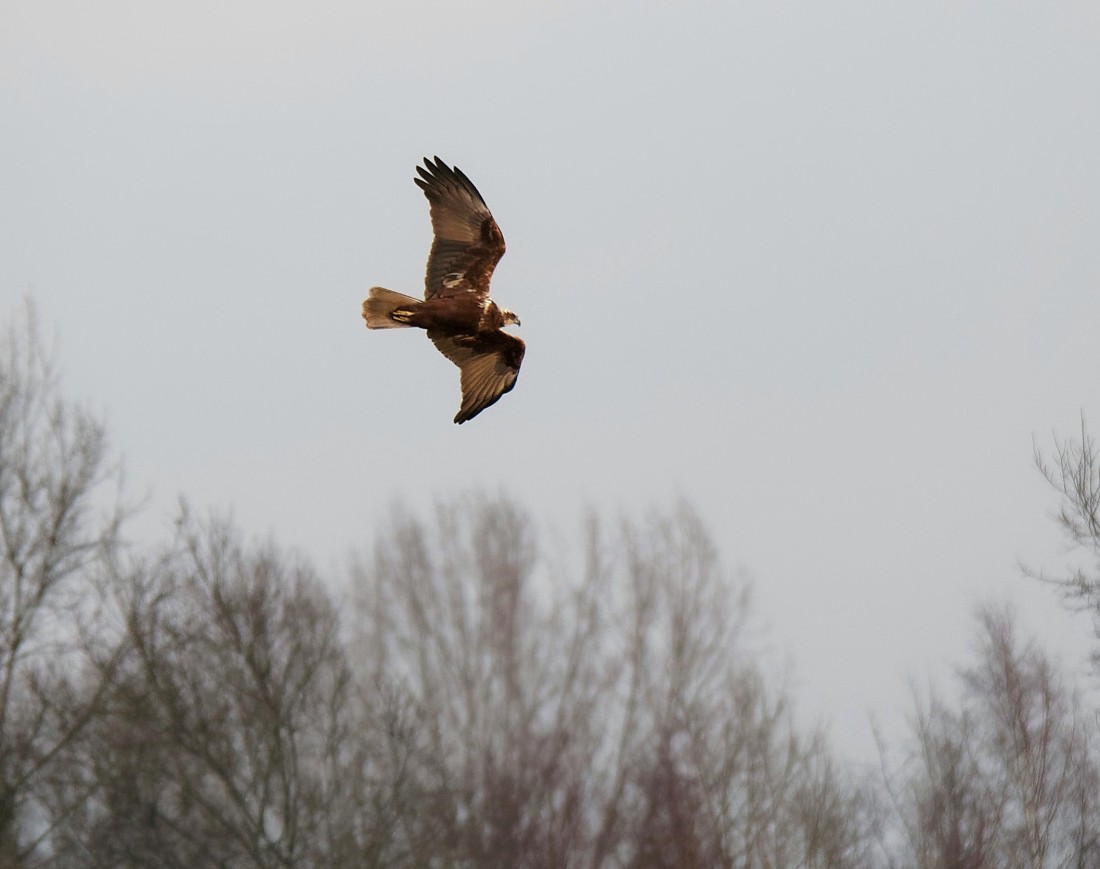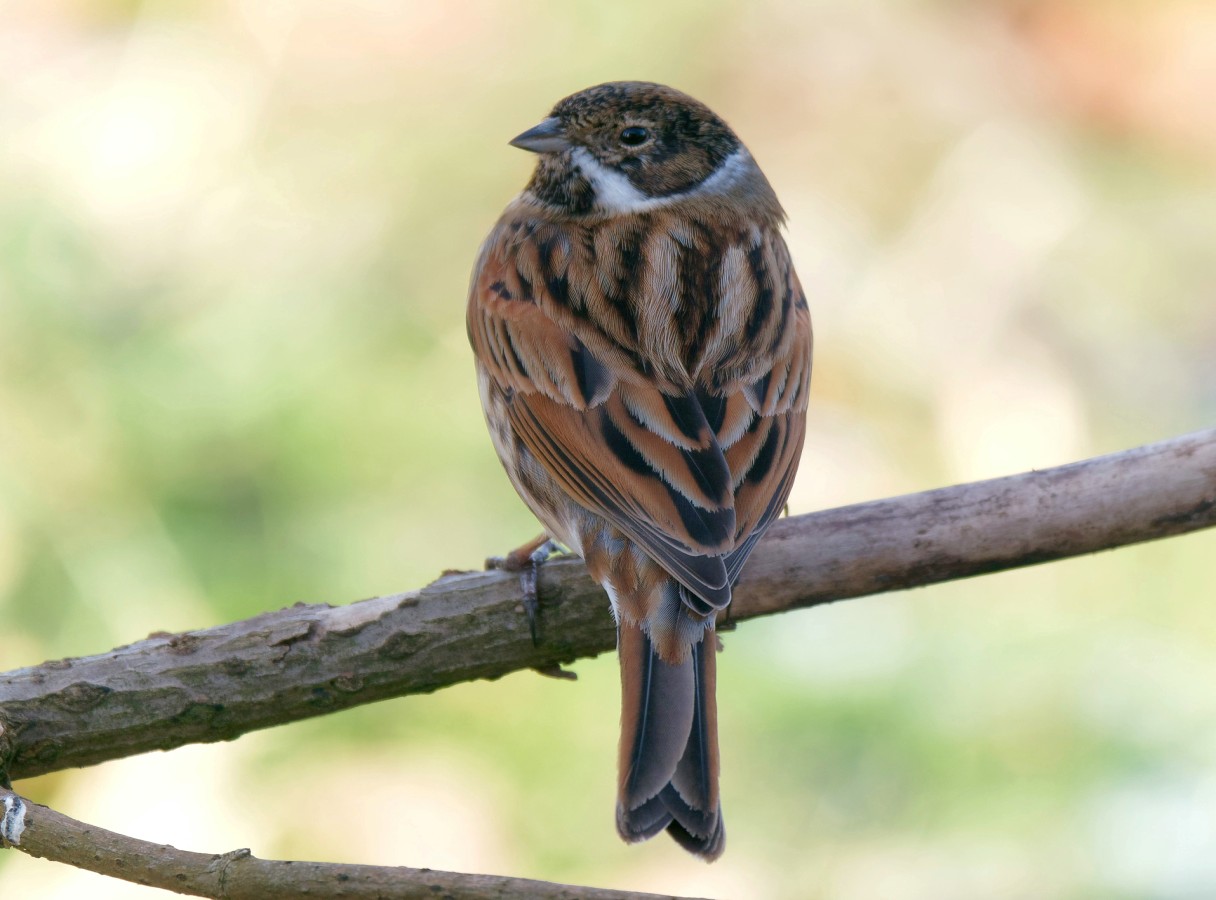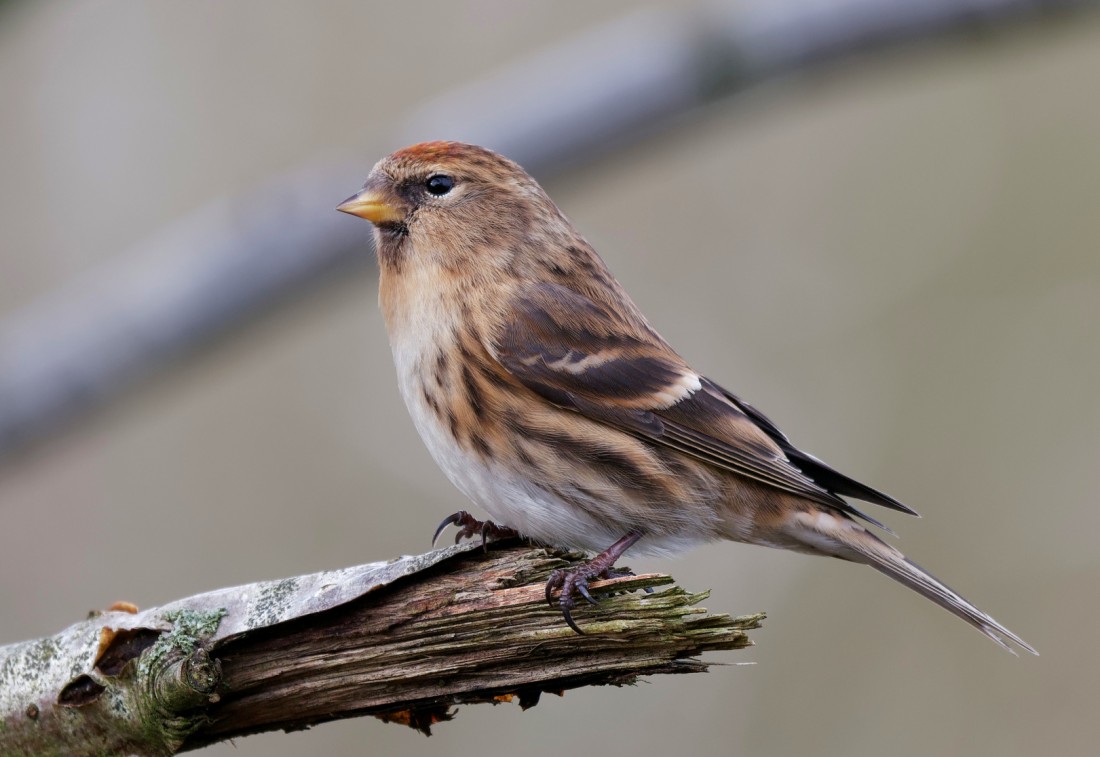Woolston Eyes Monthly Sightings
2021-02-27
Despite the ideal conditions, of blue skies and a light south-easterly breeze, there was no sign of any movement, so the focus was on enjoying the incessant pre-breeding activity, particularly of the 500 or so Black-headed Gulls, some of which were encouraged into early mating by the warmth of the day. A Mediterranean Gull which left the bed and flew across the Ship Canal was probably the same one which has been present for a few days. The male Peregrine which stirred up the gulls was, more than likely, from our resident breeding pair. Finally, a Brambling, was ringed by Kieran Foster’s ringing team and hopefully, we’ll see plenty more of in the coming weeks,, as March is peak passage time for them, as they start heading back to their Scandinavian breeding grounds. Photo of mating Black-headed Gulls Cheers David Bowman (with Helen Wynn)
Submitted by: David Bowman
2021-02-25
A beautiful late winter morning started well, with a Mediterranean Gull soaring over the No.3 bed car park before drifting south and later returning. From the Morgan Hide it was evident that there had been another arrival of Black-headed Gulls at the breeding colony, with at least 720 counted, along with a few larger gulls. Four Cetti’s Warblers were in song, while the pick of the wildfowl was a raft of 45 Pochard. There was no sign, though, of either the female Scaup or the male Garganey from yesterday. On No.4 bed, 2 Green Sandpipers, 2 Oystercatchers and 2 Snipe were with 35 Lapwings, 2 Common Gulls and 180 Black-headed Gulls, while 30 Linnets were feeding on seeds around the bunds. 200 Pink-footed Geese, moving west were also noteworthy. Photo of an Oystercatcher Cheers David (with Dave Steel, Dan Owen and Dan Gornall)
Submitted by: David Bowman
2021-02-24
A picture of the drake Garganey that has been present since Monday, the second earliest spring arrival of this species for the reserve. Also today the female Scaup spent the majority of the day on No.3 bed, 9 Curlew flew south-east this morning and a Peregrine passed through.
Submitted by: Daniel Gornall
2021-02-22
With the recent air-flow coming straight from West Africa and bringing spring-like conditions, it was a morning to be looking for early-returning migrants. Find of the day occurred while I was at a meeting on No.1 bed, when Dan Owen and Dan Gornall watched a drake Garganey drop in with some Teal and later appear in one of the South Channels. Garganey are small migratory ducks which winter in Africa and fewer than 100 pairs breed in the UK. A pair recently bred on the Reserve and hopefully will continue to do so. Soon afterwards an Oystercatcher arrived on the Morgan Hide scrape and an adult Mediterranean Gull put in a brief appearance. The latter is another potential breeding species to look out for in the coming months. Black-headed Gulls, too, were enticed by the conditions to make a mass return to the No.3 bed breeding colony. It was good to see 480 milling around, squabbling, displaying, objecting to the presence of the larger, predatory Lesser Black-backed and Herring Gulls and generally filling the bed with life. Photo of an Oystercatcher Cheers David
Submitted by: David Bowman
2021-02-18
It was blustery with driving rain at dawn at Woolston Eyes, though the weather front soon moved through, bringing blue skies from the west. The sight and sound of 150 Black-headed Gulls milling around at the breeding colony were a hint that spring might not be too far away. The long-staying Marsh Harrier then flushed 6,000 Starlings from their over-night roost, while three Sparrowhawks skimmed through, trying to snatch an easy breakfast. The presence of the harrier unsettled the 60 Pochard and 120 Tufted Ducks out on the water and while they were circling the bed they were accompanied by a drake Pintail and a drake Goldeneye, with the former dropping back in, while the Goldeneye headed for the Weir Basin. Once a common wintering species on the Reserve, Pintails are now pretty uncommon, so it was nice to have good views of this most elegant of our wildfowl. Record shot of the Pintail Cheers David
Submitted by: David Bowman
2021-02-16
A photo of the 1st-winter female Scaup that was on No.3 bed along with 306 Tufted Duck & 54 Pochard
Submitted by: Daniel Gornall
2021-02-16
After the recent bitter weather it was an almost balmy day at Woolston Eyes, with the sunshine triggering a lot of breeding behaviour amongst the wildfowl. Most interesting was the sight of a pair of Wigeon mating in front of the Morgan Hide, something I’ve not observed here before. Wigeon are a scarce breeder in the UK, with maybe just 400 breeding pairs, predominantly in Scotland. It might just be wishful thinking but I’m hoping they’re tempted to stay and breed. Raptors were also active, with the local Buzzards, Sparrowhawks and Kestrels joined by the regular Marsh Harrier and a hunting female Merlin. Out on the water, the 67 Pochard, alongside 170 Tufted Ducks, was our highest count of the year, so far. Over on No.4 bed, the new wetland was jumping with birds, with totals of: 1 Green Sandpiper, 1 Merlin (the same one, I think), 9 Pied Wagtails, 15 Linnets, 80 Redwings, 50 Pink-footed Geese heading west, 100 Lapwings, 70 Black-headed Gulls, the odd Common, Herring and Lesser Black-backed Gull, 55 Gadwall, 45 Shoveler and 58 Coot. Photo of the Morgan Hide Cheers David
Submitted by: David Bowman
2021-02-13
A bitter south-easterly wind made for a chilly dawn start at Woolston Eyes this morning but the birds, as ever, made it worth the frozen fingers. You know it’s cold when you see 11 Robins feeding together under the Morgan Hide feeders, all spaced out a yard apart as if placed by hand. Robins are notoriously territorial and will aggressively defend a feeding territory in winter, so it takes pretty harsh conditions to force them to share such a rich feeding site. It was also good to see the long-staying and well-marked female Marsh Harrier emerging from her roost and hunting throughout the whole morning. Marsh Harriers don’t usually breed until their third year and I remain hopeful that this bird will stay and find a mate in the spring, to give us our first breeding record. Two passing Ravens, possibly the local breeding pair, were also noteworthy. The link is to a short video mainly showing the hunting Marsh Harrier, but also a group of Coot working to keep a pool open in the ice, a bathing Great Black-backed Gull and a female Reed Bunting. To watch David’s video CLICK HERE…. or copy the following link into your browser. https://youtu.be/QNVRqgCuZo0 Photo of the Marsh Harrier Cheers David (with Helen Wynn)
Submitted by: David Bowman
2021-02-10
Though the lagoons were mainly frozen, groups of water-birds were working vigorously to keep small pools open. On No.3 bed there were 50 Teal, 21 Coot plus the odd Gadwall, Shoveler and Canada Goose, while the new No.4 bed wetland was still holding on to 37 Coot, 8 Shovelers and 10 Gadwall. With such cold weather coming in from the north east, there is always the chance of turning up a rare gull, so I’ve been regularly checking the gatherings of gulls on the largely unfrozen Ship Canal, thus far without any luck. Nevertheless, it was good to find 12 Common Gulls (a bit scarcer than they sound!), 150 Black-headed Gulls and a few Herring, Lesser Black-backed and Great Black-backed Gulls, split between the Canal and the No.4 bed wetland. Back on No.3 bed a couple of Woodcock, a Brambling and two Lesser Redpolls were the pick of the bunch. Photo of a male Reed Bunting Cheers David
Submitted by: David Bowman
2021-02-06
Around No.3 bed a few Little and Great Crested Grebes have already returned, with the latter briefly displaying. The 9 female Pochard out on the water, with the more numerous males, were also likely to be from our returning breeding population. Equally, the 100 or so Black-headed Gulls which dropped onto the lagoon were probably from our breeding colony. They tend to come and go till late March when they will be joined by 1,000 or so more and their raucous squabbling will then be our soundtrack till the end of the summer. In terms of movement, it was nice to see our first Oystercatcher of the year, which dropped onto one of the nest rafts, as well as four skeins of Pink-footed Geese. The geese came in high from the south-east, probably returning from feeding grounds in Norfolk and circled a few times before drifting northwards, no doubt looking for somewhere to rest and feed. Photo of a Lesser Redpoll Cheers David
Submitted by: David Bowman
2021-02-04
With hazy cloud and a light south-easterly breeze, it wasn’t surprising to see three skeins of Pink-footed Geese, totalling 260 birds, heading due north early on. They were probably on course for the coast of Scotland to feed up before making the final hop to their breeding grounds, in Iceland and Greenland, in spring. Out on the water, 10 Pochard and two Wigeon were with the commoner wildfowl, while 12 Bullfinches and two Willow Tits were the pick from the Morgan Hide feeding station. At the Hogg Hide, it was nice to pick out a single Brambling and two Lesser Redpolls among the scores of commoner finches and tits. Lesser Redpolls used to be a regular breeding bird on the Reserve and I remain optimistic that they’ll return one day. While a handful of Bramblings have been around for most of the winter, March is our peak month for Brambling passage, so worth looking out for. Photo of a male Bullfinch Cheers David
Submitted by: David Bowman

